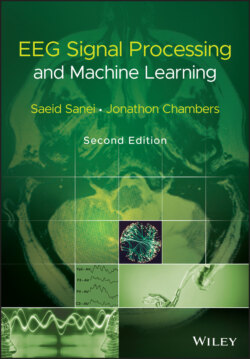Читать книгу EEG Signal Processing and Machine Learning - Saeid Sanei - Страница 66
4.5 Signal Transforms and Joint Time–Frequency Analysis
ОглавлениеIf the signals are statistically stationary it is straightforward to characterize them in either time‐ or frequency‐domains. The frequency‐domain representation of a finite‐length signal can be found by using linear transforms such as the (discrete) Fourier transform (DFT), cosine transform (DCT) or other semi‐optimal transform, which have kernels independent of the signal. However, the results of these transforms can be degraded by spectral smearing due to the short‐term time‐domain windowing of the signals and fixed transform kernels. An optimal transform such as Karhunen–Loéve transform (KLT) requires complete statistical information, which may not be available in practise.
Figure 4.2 (a) An EEG seizure signal including preictal, ictal, and postictal segments, (b) the error signal and (c) the approximate gradient of the signal, which exhibits a peak at the boundary between the segments. The number of prediction coefficients p = 12.
Parametric spectrum estimation methods such as those based on AR or autoregressive moving average (ARMA) modelling can outperform the DFT in accurately representing the frequency‐domain characteristics of a signal, but they may suffer from poor estimation of the model parameters mainly due to the limited length of the measured signals. For example, in order to model the EEGs using an AR model, accurate values for the prediction order and coefficients are necessary. A high prediction order may result in splitting the true peaks in the frequency spectrum and low prediction order results in combining peaks in close proximity in the frequency domain.
For an AR model of the signal x(n) the error or driving signal is considered to be zero‐mean white noise. Therefore, by applying z‐transform to Eq. (4.14), dropping the block index m, and replacing z by ejω we have:
(4.16)
where, E(ω) = Kω (Constant), is the power spectrum of the white noise and Xp (ω) is used to denote the signal power spectrum. Hence,
(4.17)
and the parameters Kω , ak , k = 1, …, p, are the exact values. In practical AR modelling these would be estimated from the finite‐length measurement, thereby degrading the estimate of the spectrum. Figure 4.3 provides a comparison of the spectrum of an EEG segment of approximately 1550 samples of a single‐channel EEG using both DFT analysis and AR modelling.
The fluctuations in the signal DFT as shown in Figure 4.3b is a consequence of the statistical inconsistency of periodogram‐like power spectral estimation techniques. The result from the AR technique (Figure 4.3c) overcomes this problem provided the model fits the actual data by selecting a proper prediction order for the AR estimates. EEG signals are often statistically nonstationary, particularly where there is an abnormal event captured within the signals. In these cases the frequency‐domain components are integrated over the observation interval and do not show the characteristics of the signals accurately. A TF approach is the solution to the problem.
In the case of multichannel EEGs, where the geometrical positions of the electrodes reflect the spatial dimension, space–time–frequency (STF) analysis through multiway processing methods has also become popular [15]. The main concepts in this area together with the parallel factor analysis (PARAFAC) algorithm will be reviewed in Chapter 17 aimed at detection of movement‐related potentials or eye‐blinking artefacts from the EEG signals.
The STFT is defined as the discrete‐time Fourier transform evaluated over a sliding window. The STFT can be performed as:
(4.18)
Figure 4.3 Single‐channel EEG spectrum. (a) A segment of an EEG signal with a dominant alpha rhythm. (b) Spectrum of the signal in (a) using DFT. (c) Spectrum of the signal in (a) using a 12‐order AR model.
where the discrete‐time index n refers to the position of the window w(n). Analogous with the periodogram a spectrogram is defined as:
(4.19)
Based on the uncertainty principle, i.e. , where and are respectively time and frequency‐domain variances, perfect resolution cannot be achieved in both time‐ and frequency‐domains. Windows are typically chosen to eliminate discontinuities at block edges and to retain positivity in the power spectrum estimate. The choice also impacts upon the spectral resolution of the resulting technique, which, put simply, corresponds to the minimum frequency separation required to resolve two equal amplitude‐frequency components.
Figure 4.4 shows the TF representation of an EEG segment during the evolution from preictal to ictal and to postictal stages. In Figure 4.4 the effect of time resolution has been illustrated using a Hanning windows of different durations of one and two seconds. Importantly, in Figure 4.4 the drift in frequency during the ictal period is observed clearly.
